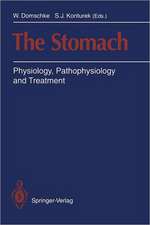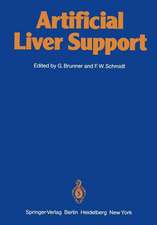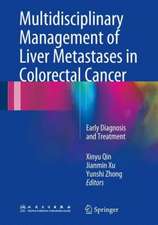Artificial Liver Support: Concepts, Methods, Results
Contribuţii de K. Akamatsu, H. Aoki Editat de G. Brunner Contribuţii de W.S. Arnaout Editat de M. Mito Contribuţii de G. Backfisch, J. Bahlmann, S. Bengmark, P.D. Berk, R. Beyrau, G. Blumhardt, M. Burdelski, J. Chang, T.M.S. Chang, A.A. Demetriou, G.-M. Eisenbach, N. Fausto, P. Flake, M. Gaab, G. Gubernatis, B.V. Harmon, D. Henne-Bruns, A.A. Ivanyuk, B. Jeppsson, S. Kasai, J.F.R. Kerr, O. Klinge, M. Kodama, M. Kusano, P. Lamesch, W. Lauchart, T.S. Lie, H. Lösgen, P.S. Malchesky, G.A. Martini, B. Mathieu, G.K. Michalopoulos, Y. Miura, A.D. Moscioni, P. Neuhaus, V.G. Nikolaev, H. Nomura, Y. Nose, M. Oellerich, Y. Ohta, V. Otto, K. Ozawa, R. Pichlmayr, B.J. Potter, B. Ringe, V.V. Sarnatskaya, M. Sawa, F.W. Schmidt, J. Searle, Y. Shimahara, T. Tani, D. Tsikas, N. Tygstrup, R. Viebahn, S. Wagner, K. Yagi, N. Yamamoto, L.A. Yushko, L. Zieveen Limba Engleză Paperback – 8 dec 2011
Preț: 725.79 lei
Preț vechi: 763.99 lei
-5% Nou
Puncte Express: 1089
Preț estimativ în valută:
138.88€ • 145.49$ • 115.10£
138.88€ • 145.49$ • 115.10£
Carte tipărită la comandă
Livrare economică 08-22 aprilie
Preluare comenzi: 021 569.72.76
Specificații
ISBN-13: 9783642773617
ISBN-10: 3642773613
Pagini: 472
Ilustrații: XVI, 450 p.
Dimensiuni: 155 x 235 x 25 mm
Greutate: 0.67 kg
Ediția:2nd ed. 1992. Softcover reprint of the original 2nd ed. 1992
Editura: Springer Berlin, Heidelberg
Colecția Springer
Locul publicării:Berlin, Heidelberg, Germany
ISBN-10: 3642773613
Pagini: 472
Ilustrații: XVI, 450 p.
Dimensiuni: 155 x 235 x 25 mm
Greutate: 0.67 kg
Ediția:2nd ed. 1992. Softcover reprint of the original 2nd ed. 1992
Editura: Springer Berlin, Heidelberg
Colecția Springer
Locul publicării:Berlin, Heidelberg, Germany
Public țintă
ResearchCuprins
I: General Aspects of Hepatic Failure.- Acute Liver Failure: History and Epidemiology.- Biochemistry of Liver Failure.- Mechanisms of Liver Cell Destruction.- Morphologic Aspects of Hepatic Regeneration.- Mechanisms of Regulation of Liver Regeneration.- Liver Regeneration: Molecular Mechanisms of Growth Control.- Animal Models of Hepatic Failure and Hepatic Encephalopathy.- Methods for the Assessment of Liver Function and Liver Regeneration.- Assessment of Liver Function in Donors by Use of the MEGX Test.- History of Artificial Liver Support.- II: Conservative Treatment.- Conservative Clinical Treatment of Acute Liver Failure.- Diagnosis and Therapy of Increased Intracranial Pressure and Brain Edema in Fulminant Hepatic Failure.- III: Hemoperfusion, Liver Perfusion, Dialysis, and Plasma Exchange.- Absorption Therapy in Acute Liver Failure: A Critical Resumé.- Selective Sorbent Hemoperfusion for Endotoxin.- Thermodynamic Criteria for the Removal of Certain Hepatic Insufficiency Markers from Protein-Containing Solutions.- Extracorporeal Hemoperfusion Over the Human and Baboon Liver.- Improved Methods of Extracorporeal Liver Perfusion for Temporary Replacement of Liver Function.- Pulmonary Microembolism Due to Plasma Exchange Replaced by Fresh Frozen Plasma.- Improved Plasma Exchange for the Treatment of Fulminant Hepatic Failure by Plasma Replacement into the Femoral Artery.- IV: Isolated and Immobilized Hepatocytes and Liver Tissue.- Cryopreserved Hepatocytes for Fluid Bed Reactors.- Artificial Cells for Artificial Liver Support.- Characteristics of Hepatocytes Immobilized Within Calcium Alginate and of a Bioreactor for Artificial Liver Support.- Immobilized Isolated Liver Cells on a Biomatrix.- Transplantation of Hepatocytes into the Spleen.- Problems and Controversieswith Transplantation of Isolated Hepatocytes for Artificial Liver Support.- V: Enzymatic Liver Support and Lipophilic Hollow-Fiber Membranes.- Enzyme Preparation for Optimal Extracorporeal Enzymatic Detoxification.- Lipophilic Hollow Fiber Membranes for Enzymatic and Nonenzymatic Detoxification of Endogenous Lipophilic Toxins in Liver Disease.- Removal of Lipophilic Toxins from Blood by Matrix-Supported Lipid Materials.- Development of a Machine for Extracorporeal Removal of Lipophilic and Hydrophilic Toxins in Liver Failure.- VI: Surgical Support and Transplantation.- Can Resection of Cirrhotic Liver Stimulate Liver Regeneration?.- Intravasal Sclerotherapy of Esophagus and Fundic Varices as Therapy and Prophylaxis of Chronic Liver Failure.- Liver Transplantation Today: Indications and Results.- Hepatic Mitochondrial Redox Potential in Liver Transplantation and Artificial Liver Support.- Present Techniques and New Ideas for Liver Transplantation.

























